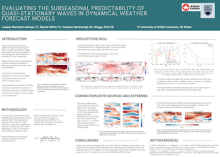Evaluating the Subseasonal Predictability of Quasi-Stationary Waves in Dynamical Weather Forecast Models
Lualawi Mareshet
Admasu
University of British Columbia
Poster
Quasi-stationary Rossby waves (QSWs) modulate long-lasting (one week or longer) atmospheric ridges and troughs, and thus are related to blocking weather and extreme events in the midlatitudes. Due to the persistent nature of QSWs, often with timescales longer than 10-15 days, they provide a unique opportunity to improve subseasonal forecasts of extreme events. Here, we evaluate the global and regional predictability of QSWs in dynamical forecast models and characterize their variability during winter months. The analysis is performed on four dynamical forecast models from the S2S project in comparison to ERA5 reanalysis data. Models show varying predictability with, as expected, higher skill at earlier times decaying as the lead time increases. The skill also shows strong spatial and interannual variability, with some regions, and some years, showing substantially improved skill over others consistently among different models. We investigate the relationship of QSW skill with waveguides, blocking and SSTs by analysing composites of seasonal averaged skill during winter months. QSW skill shows some relationship with SST anomalies, particularly in the Pacific, and with the existence of atmospheric waveguides in some regions.

Poster file
Admasu_Lualawi_Blocking_Poster.pdf
(2.3 MB)
Meeting homepage
